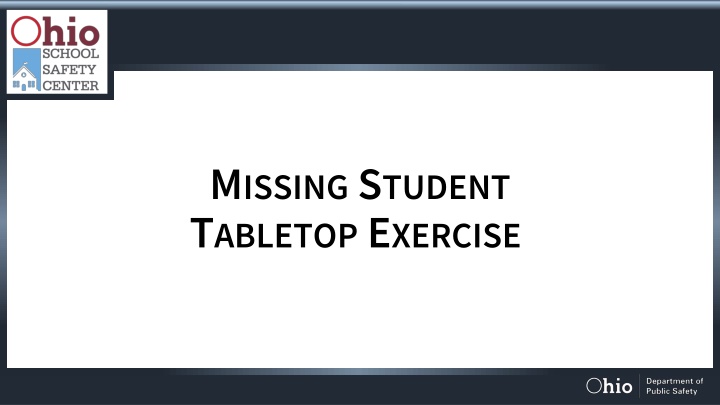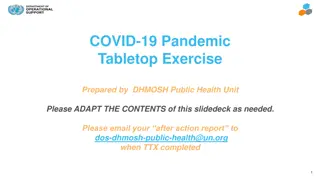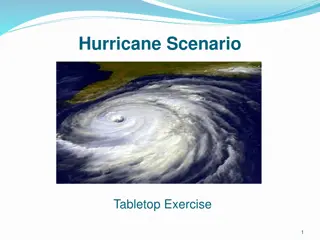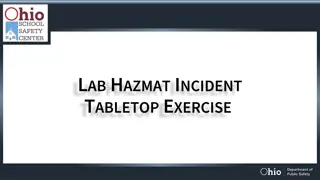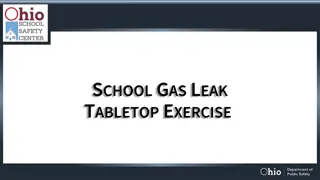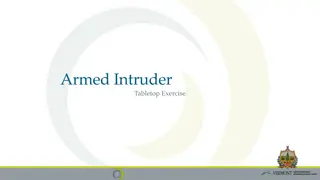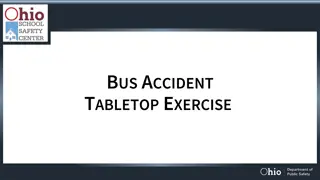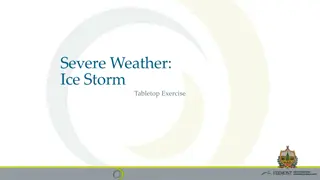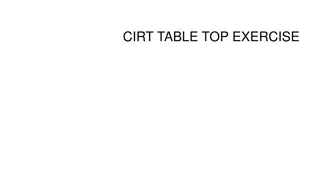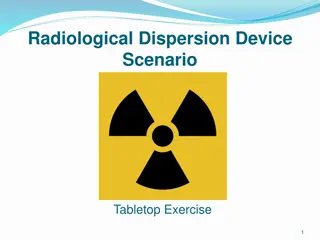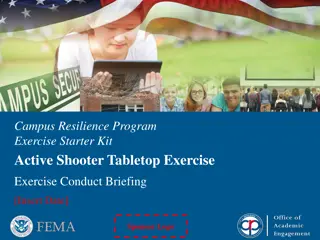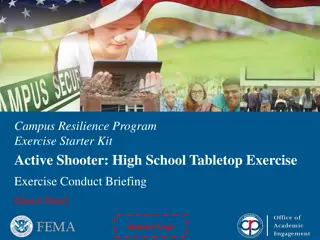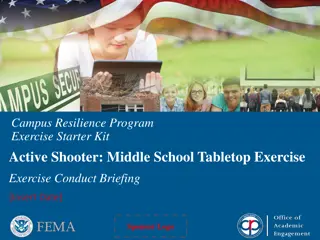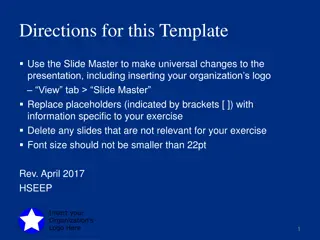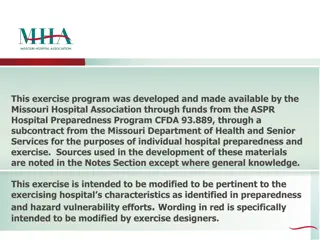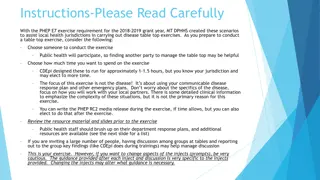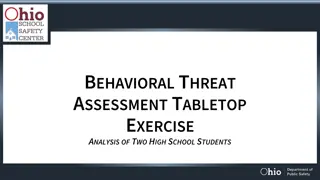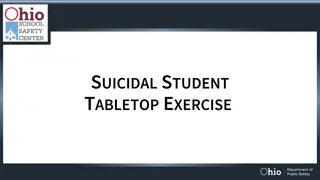School Emergency Management Tabletop Exercise
This tabletop exercise focuses on enhancing emergency management preparedness in schools. Participants engage in simulating hypothetical scenarios, discussing response strategies, assessing policies, and identifying areas for improvement. The exercise aims to increase awareness, validate procedures, and update policies to effectively respond to potential incidents. Roles are defined for players, facilitators, evaluators, and observers to ensure a structured and beneficial exercise experience.
Download Presentation

Please find below an Image/Link to download the presentation.
The content on the website is provided AS IS for your information and personal use only. It may not be sold, licensed, or shared on other websites without obtaining consent from the author.If you encounter any issues during the download, it is possible that the publisher has removed the file from their server.
You are allowed to download the files provided on this website for personal or commercial use, subject to the condition that they are used lawfully. All files are the property of their respective owners.
The content on the website is provided AS IS for your information and personal use only. It may not be sold, licensed, or shared on other websites without obtaining consent from the author.
E N D
Presentation Transcript
MISSINGSTUDENT TABLETOP EXERCISE
MISSING STUDENT TABLETOP EXERCISE Welcome & Introductions SLIDE 2
ADMINISTRATION 1. Registration 2. Exits and Restrooms 3. Emergency Evacuation 4. Cell Phones 5. Questions SLIDE 3
INTRODUCTION 1. Who are you? 2. What agency are you from? 3. What is your role today? SLIDE 4
SCHEDULE 2:00 Registration 2:15 Welcome and Introductions 2:30 Purpose and Objectives 2:45* Scenario 3:15 After Action Report 3:30 Questions to Consider 3:45 What did you Discover? 4:00 End of Exercise * 10 minute break included at the end of the Scenario The entire process is designed to be completed in 2 hours SLIDE 5
TABLETOP EXERCISE The most basic emergency management test is a tabletop exercise. Typically, this exercise happens in an informal setting. The intent is to discuss various issues regarding a hypothetical, simulated emergency. Tabletop exercises enhance general awareness, validate plans and procedures, and rehearse potential situations. Additionally, they assess the systems your school needs to prevent, mitigate, respond and recover during a defined incident. Tabletop exercises facilitate conceptual understanding, identify strengths and areas for improvement, and/or achieve changes in attitudes. SLIDE 6
ROLESAND RESPONSIBILITIES Players Represent your agency & discuss your planned response to the scenario Facilitators Moderate the flow of discussion. Keep the tabletop exercise moving and on-track Evaluators Record strengths, note areas of improvement, and capture lessons learned Observers Gain insight from the exercise. Refrain from interjecting during the exercise & be respectful SLIDE 7
THE PURPOSE 1. Increase awareness and develop an if-then mindset for school staff, and administrators. 2. Determine if current policy, procedure and practice is adequate for the exercise incident. 3. Facilitate updating the school policy and procedure for incidents that might happen. SLIDE 8
OBJECTIVES Review the Emergency Operation Plan for your school during the exercise for areas for improvement. Review your lost child policy during the exercise for areas for improvement. SLIDE 9
SCENARIO: THE MISSING STUDENT It is a Wednesday afternoon at 4:15 PM on a 30 degree winter day at a K-5 Ohio School. It is forecasted for heavy snow starting tonight at 7:00 PM. SLIDE 10
SCENARIO CONTINUES You are just starting to unwind and leave for the day. The phone rings and a distraught mother of a 4th grade girl notifies you that her child should have gotten off the bus 15 minutes ago and never arrived home. The student is the last stop on the bus route. The family has been in the neighborhood for awhile and the school is aware of a custody issues. What steps do you take? Who do you notify? How do you communicate with mother, bus driver, law enforcement and bus director? SLIDE 11
AFTER ACTION REPORT A review of your response to the incident should be completed as a part of the process. This is called an "after-action report". Answer the questions below. Is your response adequate for the scope of the incident? Does the response fall within your current policy and procedure? If the answer is no should the policy/procedure be updated? If a change is needed, who will facilitate the change? What is the timeline to update the policy/procedure? SLIDE 12
CONTINUED QUESTIONSTO CONSIDER Is your response reasonable? Is it realistic; can it be carried out operationally? Are all those involved in the response aware of their roles? Are they trained and available? Do you have a current Memorandum of Understanding (MOU) or do you need to update it? (Law Enforcement, EMS, Mental Health, Grief Counselors, etc.) Was communication adequate during the response? Were the appropriate people notified? SLIDE 13
CONTINUED QUESTIONSTO CONSIDER Are there Public Relations concerns in the scenario? Are they adequately addressed in your response? Can an operational change be made to mitigate or prevent a future occurrence of this type of incident? Be aware that your answers to these questions will drive the improvement process for your Emergency Operations Plans. SLIDE 14
WHAT DID YOU DISCOVER? What did you discover during your After-Action Review? Does any part of your emergency plan need to be updated based on what you ve learned? Do any systems, equipment or practices need to be updated? Is additional training warranted to facilitate the proper execution of this response? Are additional resources needed to complete the response successfully? If any of the answers to the above questions are, "yes", identify who will be responsible and what is the timeline to make the changes identified. SLIDE 15
THANK YOU! Please remember that schools must complete a functional, full-scale, and tabletop exercise during the three-year period between resubmission of an annual emergency operation plan, and each type of test can only be used once. Sample tabletop exercise tool kits are available on the Ohio School Safety Center Website. Please engage your school safety team when planning your test. After completion, don't forget to document the test and after-action report in OH|ID. Step-by-step instructions for submitting your after-action report can be found here. SLIDE 16
